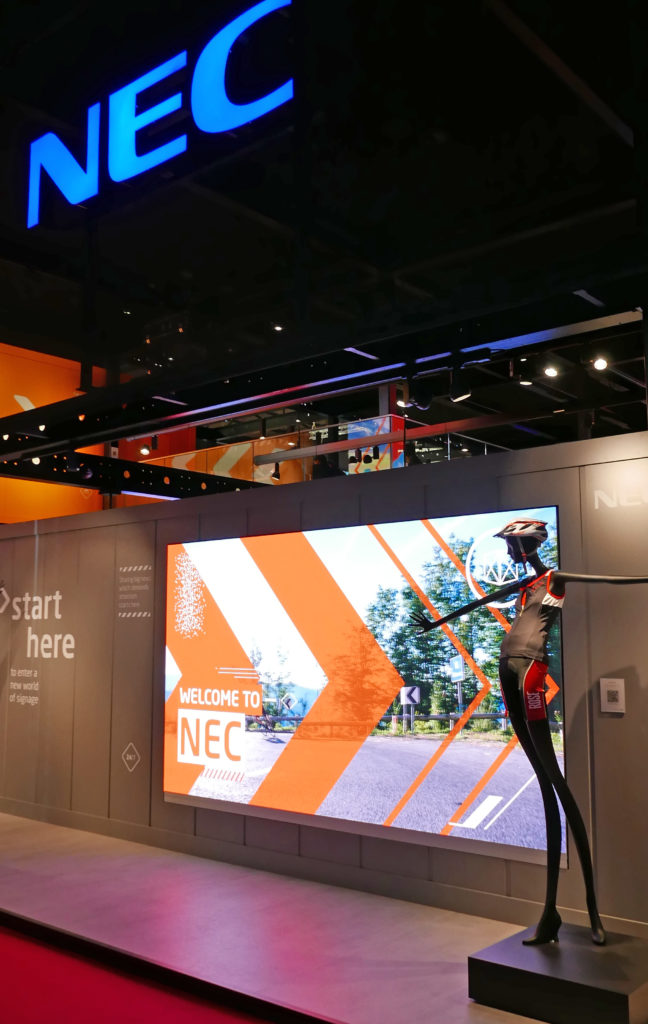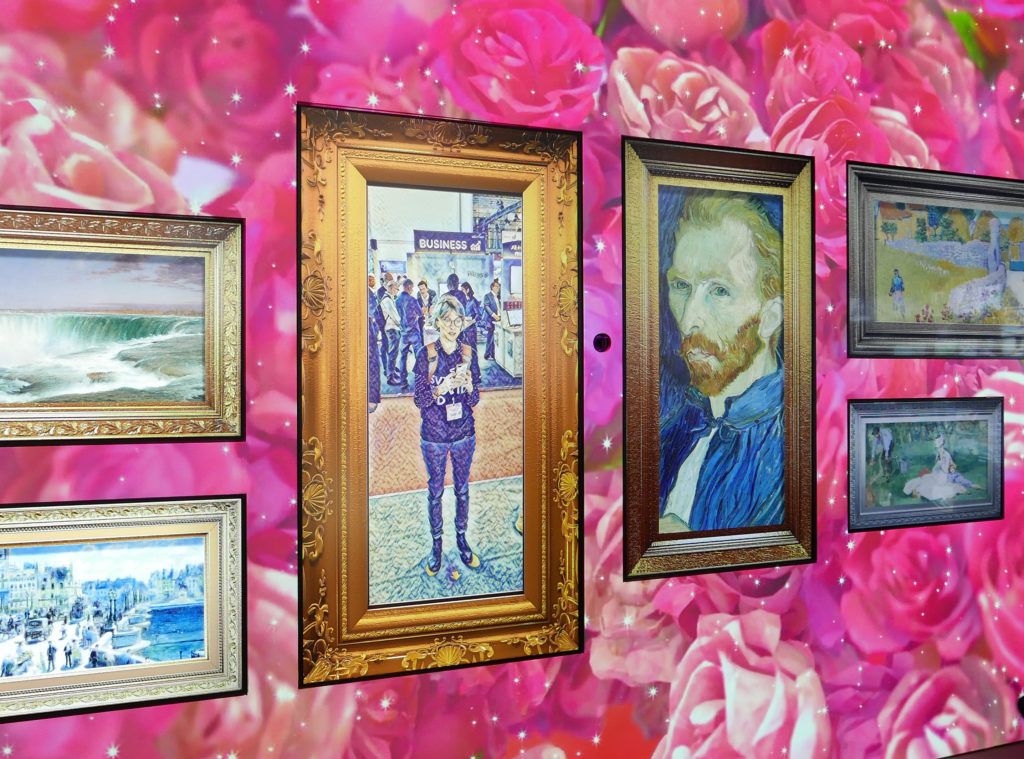
March 1, 2019
By David Keene
At ISE 2019 in Amsterdam last month (Integrated Systems Europe) there were some big trends for a big trade show – the largest AV trade show and conference on the planet. A few of the biggest trends? More (and more) direct view LED; LED mounting issues rising on integrators’ radar for both outdoor and indoor applications; and more Cloud solutions for both set-up and control, and for firmware updates to gear in field.
Direct view LED is course the biggest, brashest, loudest kid on the block today. At ISE it was everywhere. Fine pixel pitch is being pushed by all the LED manufacturers, and “fine pitch” is a target that keeps moving (downward of course, especially on the finest end). At ISE there were demos of LED in the .8mm pixel pitch range. Samsung, Absen, Unilumin, Nanolumens, Leyard, and Christie were among the manufacturers to weigh in with the most super fine pixel pitch LED. (Impossible to list all the suppliers at ISE, there were many.)
While the .8 range LED is sexy and sleek, in the field/market the sweeter spot, today, is 1.2mm to 2.5mm. That’s were the customers are spending most of the money when it comes to fine pitch LED. But finer pitch will come to market faster than you think.
At ISE, with so much LED on show, I can just scratch the surface here. I will point out two companies that stood out for innovation in LED: Samsung, and Christie.

Christie debuted the new MicroTiles LED at ISE.
Christie raised eyebrows when they announced on the eve of ISE 2019 that they were going to launch at the show, a decade after the launch of the original Christie MicroTiles (those DLP-based rear projection cubes), a new and all direct view LED version, called MicroTiles LED. And indeed, Christie MicroTiles LED made its debut at ISE 2019 in Amsterdam. Of course only AV and DLP geeks care a lot about the storied history of the original DLP MicroTiles – that were, granted, pretty revolutionary in their day. And with the new MicroTiles LED launch at ISE (there are both 1.25 and 1.5mm options) some asked if the 2019 versions will set them apart from a big crowd of LED providers. In this analyst’s opinion, after meeting with Ted Romanowitz of Christie and getting a demo at ISE, I feel Christie is going beyond just “another LED product” with MicroTiles LED. Why? It’s in the design architecture and the power, mounting, and content delivery details. With their E1000 controller, or the E1100, 4:4:4 i.e. full chroma sampling from the source is maintained (not sliding to chroma subsampling). The up to 40GB connection, PoE, single cable is great (cost and complexity is removed – no ribbon cables, just one cable.) 12-bit 4K color at 120Hz, input sources with HDR10 compliance, and P3 are important to note. The mounting on the demo in the Christie booth was elegant – and the screen seemed to float in the air, in the space. The low profile QuickMount system means displays can be created in any shape and size, including concave and convex curves. (At the demo in the booth, vertical mounting of the LED tiles allowed for more left-to-right curve to the video wall.) All in all, an architecturally friendly, modular, high res, high horse power video processing LED video wall solution – a very worthy successor to the original MicroTile.
Samsung’s big hit at ISE – in a booth that was full of impressive LED displays– was The Wall. The Wall has dazzled everyone, at every trade show at which I’ve seen it. And it keeps getting better: Samsung has made it HDR10+ compatible, going beyond basic HDR specs to territory few venture into. And HDR at its top reaches, are at the heart of the best LED. Remember, HDR is not just more contrast ratio (though few people even in the AV world can explain why). Why? It’s about the greater color space that the best HDR enables. When you add contrast, with HDR, that contrast is applied to each color, so you are not just increasing “contrast ratio”, you expand the color space. You actually create more colors. And the better the HDR you do, the more you get beyond 709 and get to Rec. 2020. Both higher contrast, and more colors. And HDR metadata (as well as Dolby metadata) does not take much bandwidth, so it’s not a jump in bandwidth needed. LED is about who does HDR better. And that’s the arena where the better LED providers will win, in critical areas of AV, control room, and other applications where the best imagery is needed. Samsung’s The Wall is in that league, and they are leveraging several technology initiatives with The Wall – from their cinema offerings (read here) to their consumer TV offerings.

Samsung’s The Wall, keeps getting better. Samsung has made it HDR10+ compatible, going beyond the HDR specs to territory few venture into.
Samsung produced a nice video of much of their booth offerings at ISE 2019. You can see it here.
When it comes to LED, there is some misconception in the industry that price alone is holding back the market for the very fine pitch product, as many customers wait for the price to come down. There’s some truth to that, but that’s not the main challenge. What is also holding back the market from going all in with fine pixel pitch is alignment issues when you go to install it. This is born out in the field – and it’s even visible when you walk around a big trade show like ISE – where amazingly there is a lot of mis-mounted and mis-aligned LED in a lot of booths. With LED, especially larger LED walls, any alignment issues are compounded. Mounting is more critical with LED than with LCD panels. And add in the maintenance issues that get translated to mounting/set up issues: LED modules get damaged, in installation. That’s a maintenance issue and a mounting issue. Interestingly (if not confusingly) for AV integrators: almost all of the LED display manufacturers offer their own mounting solutions – but they all work with the separate top mounting companies quite a bit: Premier Mounts, Peerless-AV, Chief, RP Visual Solutions, and others. The bottom line: all walls are not created equal. All mounting surfaces are different. And with LED, there is so much variation in the format, size of video walls. You must know the mounting issues – this is not your father’s LCD video wall installation.
At ISE I caught up with Peerless-AV (not just at their legendary party) for LED mounting updates. And it was particularly interesting to talk with Curtis Rose of Premier Mounts at their booth in the Digital Signage hall. Always a great perspective on mounting issues for LED from Rose. To get the gist of it, the video he made cuts to the chase, with footage from ISE. Click here to see the video.
Another big trend at ISE: the Cloud. Yes, I know – like AI and machine learning, and IoT, when we hear more hype we start to tune out. If I had a dollar for every press release I get that has some variation of leveraging the synergies of cloud-based, enterprise-wide AI-enabled IoT etc etc, I’d retire tomorrow.
But the Cloud is important, to AV. Why? Cloud solutions for both end user control, and for firmware updates to gear in field. And add Cloud control for installation and set up of the AV systems.
One of the best ways, at the ISE show, to understand the importance of the Cloud in AV: looking at what Crestron was showing in their booth. In a huge booth – one of the biggest at ISE – my eyes went to their Cloud offerings. Remember when, with AMX and Crestron, you needed all that time-intensive programming? The evolution of this product category is telling, as these companies go “outside of the room” now with control, to other spaces as well. It’s really the story of the AV market now, beyond just AV/IP to deeper control and configuration issues.
Crestron’s XiO, built on the Microsoft Azure platform, can configure up to thousands of devices in the same time it takes to configure one. It not only reduces installation time and cost, it allows you to gather actionable usage data to optimize people, space, and technology, without all the complex programming that used to be the hallmark of Creston, AMX, etc programming-heavy control products. And in AV and IT, the greatest security threat is firmware. Crestron cloud lets you update firmware easily. This is the trend in all of AV/IT – Crestron just did a good job at ISE of driving home the message in their connected booth with lots of hands-on demos.

One of the best ways, at the ISE show, to understand the importance of the Cloud in AV: looking at what Crestron was showing in their huge booth.
At ISE the “Digital Signage” pavilion (really, as big as many trade show’s entire show floors) was lively – though many of the exhibitors were companies not on our radar. For example, many many LED providers of mysterious provenance (mysterious to most on our side of the pond, or ponds in this case). And the usual plethora of CMS companies that market directly to end users of varying levels of sophistication.
It was interesting to catch up with BrightSign in their booth in the Digital Signage “pavilion” (no mere pavilion, that, let’s call it a very large wing of RAI). I wanted to follow up with the pre-ISE article that we published here about BrightSign, on digiDaybook in late January.

Catch up with Jeff Hastings I did, and I can report that what was demo’d at ISE lived up to the press releases that BrightSign put out right before the show. And based on what I saw the entire week of ISE: end users and AV integrators are now looking to mitigate the hardware (including media player) and OS-related pitfalls and roadblocks of previous generation Digital Signage rollouts. And add to that, one of the strongest trends visible at ISE – more Cloud controlled and/or accessed AV hardware not just for control but to update firmware and more. Are there new generation, more IT-friendly Digital Signage solutions that match a dedicated-OS platform with robust, industrial grade media players that perform like well-integrated software not problematic hardware – all with Cloud control? BrightSign’s new initiatives are pretty ambitious. Between ISE, and the fast approaching Digital Signage Expo in Las Vegas, BrightSign is making a statement.

Steve Scorse of Unilumin explaining the details of Mini-LED at their booth at ISE. Mini-LED, micro LED, fine pixel pitch LED – all terms for the same thing, brought to ISE by the big playes: Unilumin, Samsung, Absen, Christie, Daktronics, Leyard, NanoLumens, and more.

At the NEC booth at ISE, LCD and direct view LED was on display, and Richard Ventura of NEC was on hand to explain how NEC can provide a new, AI and analytics solutions not just screens.

Huddle rooms are big trend in pro AV, Collaboration, and all enterprise. Harman Pro were doing their part at ISE, huddling with attendees, with AMX solutions on demo.

At ISE, with so much direct view LED on hand, Panasonic did a great jog showing the wow of both LCD displays, and video projection, and what you can do with interactive. Shown here, an interactive system that let attendees appear on pixel-crunching screens that redefined selfies for a new digital palette.

LG’s roll-up OLED at ISE. Even more impressive than the big OLED “wave” at the booth.
Market Trends – Gensler Spotlight
Get Our Newsletter
Sign up at the right to get industry analysis, curated data, and information (you can actually use) from the digiDaybook Newsletter.



